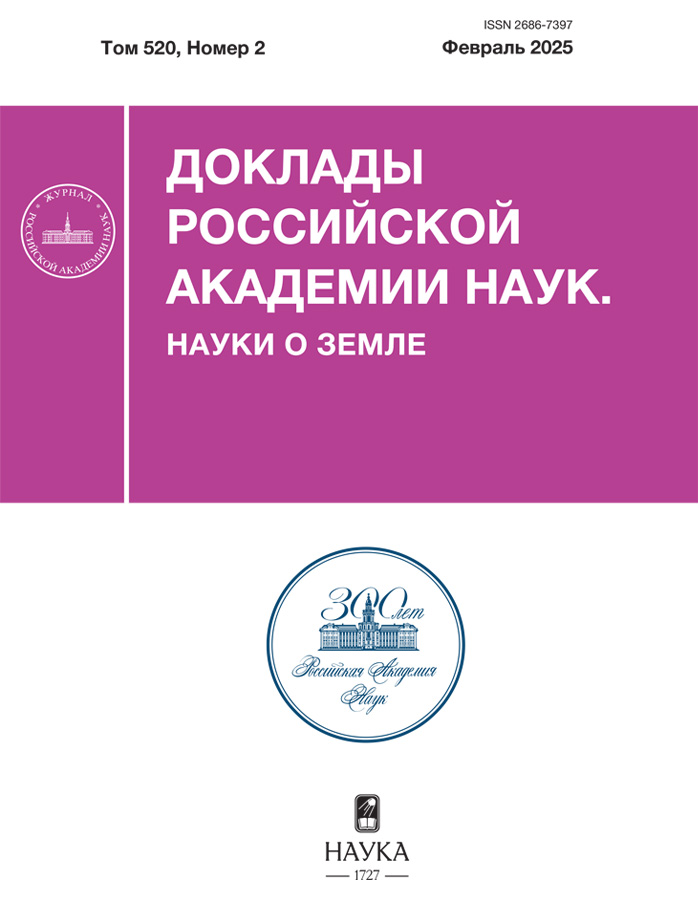West Siberian sedimentary basin. Highly heterogeneous subsidence of the earth's crust caused by metamorphism catalyzed by the influx of mantle fluids
- Autores: Artyushkov E.V.1, Chekhovich P.A.1,2
-
Afiliações:
- Institute of Physics of the Earth, Russian Academy of Sciences
- Lomonosov Moscow State University
- Edição: Volume 520, Nº 2 (2025)
- Páginas: 299-311
- Seção: GEODYNAMICS
- ##submission.dateSubmitted##: 19.06.2025
- ##submission.dateAccepted##: 19.06.2025
- ##submission.datePublished##: 19.06.2025
- URL: https://permmedjournal.ru/2686-7397/article/view/685364
- DOI: https://doi.org/10.31857/S2686739725020141
- EDN: https://elibrary.ru/GDBNWB
- ID: 685364
Citar
Resumo
Most researchers associate the formation of large sedimentary basins on the continents with strong stretching of the lithospheric layer – rifting. The formation of the world's largest West Siberian basin is explained by post-rift subsidence of the crust after rifting at the Permian-Triassic transition. Post-rift subsidence is commonly described using the classical pure shear model. Analysis of seismic profiles with a total length of 2.500 km showed that this model is not applicable to the West Siberian basin. The rate of post-rift subsidence of the crust should decrease rapidle and smoothly over time. In the West Siberian Basin, the most rapid subsidence occurred, however, not in the Triassic, immediately after the supposed stretching, but in the Jurassic and Cretaceous, when the post-rift subsidence should have been practically completed. Moreover, in the Mesozoic and Cenozoic, the subsidence of the crust was very complex, and it was highly heterogeneous both in time and area. Far from the active boundaries between the plates, such a subsidence with the accumulation of up to 6–7 km of sediments could only be caused by significant contraction of rocks in the Earth's crust as a result of prograde metamorphism, catalyzed by the influx of surface-active fluids from the mantle into the crust. The strong heterogeneity of the subsidence indicates that the influx of these fluids into the crust was also heterogeneous in time, space, and possibly composition.
Texto integral
Sobre autores
E. Artyushkov
Institute of Physics of the Earth, Russian Academy of Sciences
Autor responsável pela correspondência
Email: arty-evgenij@yandex.ru
Academician of the RAS
Rússia, MoscowP. Chekhovich
Institute of Physics of the Earth, Russian Academy of Sciences; Lomonosov Moscow State University
Email: p.chekhovich@gmail.com
Museum of Earth Science
Rússia, Moscow; MoscowBibliografia
- Artemjev M.E., Artyushkov E.V. Structure and isostasy of the Baikal rift and the mechanism of rifting // J. Geophys. Res. 1971. V. 76. P. 1197–1211.
- McKenzie D. Some remarks on the development of sedimentary basins // Earth Planet. Sci. Lett. 1978. V. 40. P. 25–32.
- Allen J.R., Allen P.A. Basin Analysis: Principles and Application to Petroleum Play Assessment, 3rd Edition, 2013, Wiley-Blackwel, 640 p.
- Добрецов Н.Л., Полянский О.П., Ревердатто В.В., Бабичев А.В. Динамика нефтегазоносных басейнов в Арктике и сопредельных территориях как отражение мантийных плюмов и рифтогенеза // Геология и геофизика. 2013. Т. 54. № 8. С. 1145–1161.
- Сурков В.С., Смирнов Л.В., Жеро О.Г. Раннемезозойский рифтогенез и его влияние на структуру литосферы Западно-Сибирской плиты // Геология и геофизика. 1987. № 9. С. 3–11.
- Артюшков Е.В., Чехович П.А. Западно-Сибирский осадочный бассейн. Отсутствие сильного растяжения земной коры по данным сверхглубокого бурения // Доклады Российской Академии наук. Науки о Земле. 2023. Т. 512. № 2. С. 251–260. https://doi.org/10.31857/S2686739723601175
- Артюшков Е.В., Чехович П.А. Западно-Сибирский осадочный бассейн. Погружение коры вследствие уплотнения пород в ее нижней части в результате проградного метаморфизма // Доклады Российской Академии наук. Науки о Земле. 2024. Т. 515. № 2. С. 258–273. https://doi.org/10.31857/S2686739724040112
- Мещеряков К.А., Карасева Т.В. Особенности формирования триасовых прогибов севера Западной Сибири в связи с нефтегазоносностью // Нефтегазовая геология. Теория и практика. 2010. Т. 5. № 10. С. 9. EDN OYQEVP
- Конторович В.А., Аюнова Д.В., Губин И.А., Ершов С.В., Калинин А.Ю., Калинина Л.М., Канаков М.С., Соловьев М.В., Сурикова Е.С., Шестакова Н.И. Сейсмостратиграфия, история формирования и газоносность структур Надым-Пурского междуречья // Геология и геофизика. 2016. Т. 57. № 8. С. 1583–1595. https://doi.org/10.15372/GiG20160810
- Конторович В.А., Аюнова Д.В., Губин И.А., Калинин А.Ю., Калинина Л.М., Конторович А.Э., Малышев Н.А., Скворцов М.Б., Соловьев М.В., Сурикова Е.С. История тектонического развития Арктических территорий и акваторий Западно-Сибирской нефтегазоносной провинции // Геология и геофизика. 2017. Т. 58. № 3–4. С. 423–444.
- Конторович В.А., Аюнова Д.В., Гусева С.М., Калинина Л.М., Калинин А.Ю., Канаков М.С., Соловьев М.В., Сурикова Е.С., Торопова Т.Н. Сейсмогеологическая характеристика осадочных комплексов и нефтегазоносность Ямальской, Гыданской и Южно-Карской нефтегазоносных областей (Арктические регионы Западной Сибири, шельф Карского моря) // Геофизические технологии. № 4. 2018. С. 10–26. https://doi.org/10.18303/2619–1563–2018–4–3
- Kaban M.K., Schwintzer P., Tikhotsky S.A. Global isostatic gravity model of the Earth // Geophys. J. Int., 1999. V. 136. P. 519–536.
- Артюшков Е.В., Чехович П.А. Роль глубинных флюидов в погружении коры древнего кратона. Осадочный бассейн Московской синеклизы в позднем девоне // Доклады Российской Академии наук. Науки о Земле. 2022. Т. 507. № 2. С. 119–131. https://doi.org/10.31857/S2686739722601843
- Общая стратиграфическая шкала // ВСЕГЕИ: МСК, 2024. Режим доступа: https://vsegei.ru/ru/about/msk/str_scale/os_scale-03-24.pdf (дата обращения: 12.08.2024)
- Конторович А.Э., Конторович В.А., Рыжкова С.В., Шурыгин Б.Н., Вакуленко, Л.Г. Гайдебурова Е.А., Данилова В.П., Казаненков В.А., Ким Н.С., Костырева Е.А., Москвин В.П., Ян П.А. Палеогеография Западно-Сибирского осадочного бассейна в юрском периоде // Геология и геофизика. 2013. Т. 54. № 8. С. 972—1012.
- Сурков В.С., Смирнов Л.В., Жеро О.Г. Раннемезозойский рифтогенез и его влияние на структуру литосферы Западно-Сибирской плиты // Геология и геофизика. 1987. № 9. С. 3–11.
- Артюшков Е.В. Физическая тектоника. М.: Наука, 1993, 457 с.
- Добрецов Н.Л., Полянский О.П. О механизмах формирования глубоких осадочных бассейнов: достаточно ли данных для доказательства эклогитизации? (Геология и геофизика, 2010. Т. 51. № 12. С. 1687–1696.
- Semprich J., Simon N.S.C., Podladchikov Yu.Yu. Density variations in the thickened crust as a function of pressure, temperature, and composition, Int. J. Earth Sci (Geol. Rundsch.) 2010. V. 99. P. 1487–1510. https://doi.org/10.1007/s00531-010-0557-7
- Artyushkov E.V., Mörner N.-A., Tarling D.L. The cause of loss of lithospheric rigidity in areas far from plate tectonic activity // Geophys. J. Int. 2000. V. 143. P. 752–776.
Arquivos suplementares













